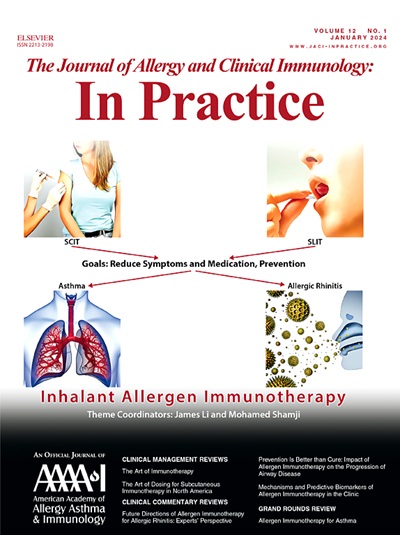Mucus Plug Score Predicts Clinical and Pulmonary Function Response to Biologic Therapy in Patients With Severe Asthma
IF 8.2
1区 医学
Q1 ALLERGY
Journal of Allergy and Clinical Immunology-In Practice
Pub Date : 2025-05-01
DOI:10.1016/j.jaip.2025.01.010
引用次数: 0
Abstract
Background
Mucus plugging has been identified as an important feature of severe asthma contributing to airway obstruction and disease severity. Recently, improvement in mucus plugging has been found on treatment with several biologic therapies.
Objectives
To analyze associations of baseline characteristic with the mucus plugging score (MPS) and to determine whether the MPS at baseline predicts the clinical and functional response to biologic treatment in patients with severe asthma.
Methods
We retrospectively analyzed biologic-naive patients with a suitable computed tomography scan available at baseline. We calculated the MPS and analyzed correlations with baseline parameters and improvements in biomarkers, pulmonary function, and clinical parameters after 4 months of biologic therapy.
Results
We included 113 patients in the baseline cohort, 101 patients of whom had sufficient data after 4 months of biologic therapy for the follow-up analysis. Computed tomography showed mucus plugging in 77% of patients (median MPS, 4). Multivariate regression analysis showed a correlation of MPS with lower FEV1 (ρ = –0.24; P = .009) and diffusing capacity for carbon monoxide (ρ = –0.26; P = .01), and higher FeNO (ρ = .36; P = .0003) at baseline. Patients received treatment with anti-IgE (8.8%), anti-IL-5 (27.4%), anti-IL-5R (37.2%), anti-IL-4R (25.7%), and anti-thymic stromal lymphopoietin (0.9%) in clinical routine. Baseline MPS correlated with improvements in FEV1 (β = 0.72; P = .01) and Asthma Control Test (β = 0.24; P = .001) in multivariate regression analysis.
Conclusion
Our study suggests that a higher MPS correlates with worse pulmonary function at baseline but also predicts a larger clinical and pulmonary function response to biologic therapies in severe asthma.
黏液堵塞评分预测严重哮喘患者对生物治疗的临床和肺功能反应。
背景:粘液堵塞已被确定为严重哮喘的一个重要特征,有助于气道阻塞和疾病的严重程度。近年来,通过几种生物疗法的治疗,发现黏液堵塞有所改善。目的:我们旨在分析基线特征与黏液堵塞评分(MPS)的相关性,并探讨MPS基线是否能预测严重哮喘患者对生物治疗的临床和功能反应。方法:我们回顾性分析biologic-naïve患者在基线时进行合适的CT扫描。我们计算MPS并分析4个月后生物治疗与基线参数、生物标志物、肺功能和临床参数改善的相关性。结果:基线队列纳入n=113例患者,其中101例患者经4个月的生物治疗后有足够的资料进行随访分析。CT显示77%的患者粘液堵塞,MPS中位数为4。多因素回归分析显示,MPS与基线时较低的FEV1 (rho= -0.24, p=0.009)、DLCO (rho=-0.26, p= 0.01)和较高的FeNO (rho=0.36 p=0.0003)相关。患者临床常规接受抗ige(8.8%)、抗il5(27.4%)、抗il5r(37.2%)、抗il4r(25.7%)、抗tslp(0.9%)治疗。基线MPS与FEV1改善相关(β =0.72;p=0.01)和ACT (β = 0.24;P = 0.001)。结论:我们的研究表明,高MPS与基线时较差的肺功能相关,但也预示着严重哮喘患者对生物治疗的临床和肺功能反应更大。
本文章由计算机程序翻译,如有差异,请以英文原文为准。
求助全文
约1分钟内获得全文
求助全文
来源期刊

Journal of Allergy and Clinical Immunology-In Practice
ALLERGYIMMUNOLOGY-IMMUNOLOGY
CiteScore
11.10
自引率
9.60%
发文量
683
审稿时长
50 days
期刊介绍:
JACI: In Practice is an official publication of the American Academy of Allergy, Asthma & Immunology (AAAAI). It is a companion title to The Journal of Allergy and Clinical Immunology, and it aims to provide timely clinical papers, case reports, and management recommendations to clinical allergists and other physicians dealing with allergic and immunologic diseases in their practice. The mission of JACI: In Practice is to offer valid and impactful information that supports evidence-based clinical decisions in the diagnosis and management of asthma, allergies, immunologic conditions, and related diseases.
This journal publishes articles on various conditions treated by allergist-immunologists, including food allergy, respiratory disorders (such as asthma, rhinitis, nasal polyps, sinusitis, cough, ABPA, and hypersensitivity pneumonitis), drug allergy, insect sting allergy, anaphylaxis, dermatologic disorders (such as atopic dermatitis, contact dermatitis, urticaria, angioedema, and HAE), immunodeficiency, autoinflammatory syndromes, eosinophilic disorders, and mast cell disorders.
The focus of the journal is on providing cutting-edge clinical information that practitioners can use in their everyday practice or to acquire new knowledge and skills for the benefit of their patients. However, mechanistic or translational studies without immediate or near future clinical relevance, as well as animal studies, are not within the scope of the journal.
 求助内容:
求助内容: 应助结果提醒方式:
应助结果提醒方式:


